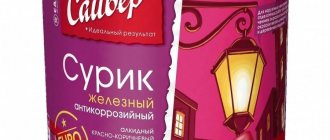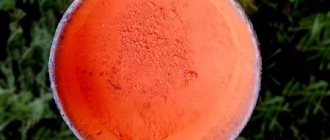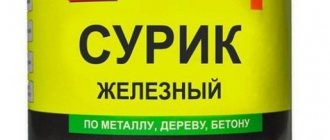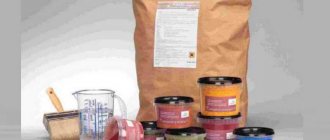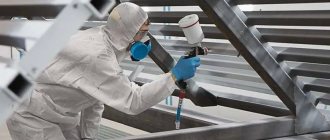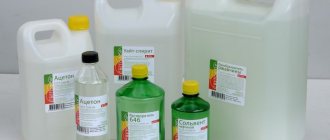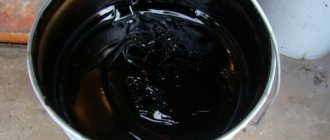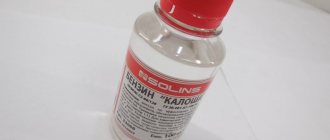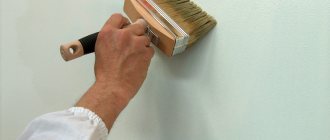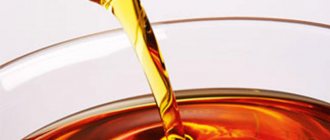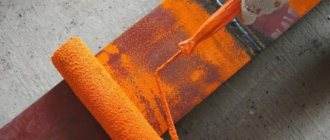Items used outdoors require additional protection. Without a special coating, they quickly deform under the influence of the environment. Heat-resistant protective coating is the best option for increasing the service life of metal coatings. Red lead is currently considered one of the most popular compounds.
Red lead is currently considered one of the most popular compounds.
Advantages and areas of application
Surik is characterized by many positive qualities:
- temperature resistance (ranging from 50 degrees below zero to 60 degrees above zero);
- hard and stable coating;
- protection of the surface from moisture and chemicals due to the film formed on the base material;
- protection against corrosive processes;
- long service life of the surface;
- economical expense.
Technical features of the material:
- drying time no more than a day;
- conditional viscosity, measured using a VZ-4 viscometer, is no more than 80 - 160 (at temperatures above 20 degrees Celsius);
- hiding power - up to 35 grams per square meter;
- mass fraction of volatile substance – up to 14.5%;
- resistance of the coating to static water for at least 3 hours at 20 degrees Celsius;
- the hardness of the coating when measured using a pendulum device is not less than 0.12 conventional units;
- degree of grinding – up to 80 micrometers;
- mass fraction of film-forming substance - from 27%.
Areas of application of red lead:
- production of varnishes, paints and primers;
- glass industry;
- automotive industry;
- production of plastics (for corrosion protection);
- production of fire-resistant impregnating compounds and paints;
- polishing glass and metal products (used as a fine abrasive).
Short description
Red lead or lead oxide is a naturally occurring pigment that is light brown or orange in color. Its formula is Pb3O4. The material is included in paints as a coloring element, and is also used in putties or primers as an anti-corrosion agent.
The size of the fine powder fractions is 2-10 microns. Produced by oxidation under high temperatures. Used batteries are used to extract lead.
The use of red lead in building materials increases their anti-corrosion properties. The oxide film appears when it reacts with metal surfaces; it protects products from corrosion. The production of the chemical compound is carried out at specialized chemical plants.
It is worth noting that this substance belongs to the first hazard class, since it is highly toxic and falls into the category of carcinogens. Based on these conclusions, red lead cannot be used in the domestic sphere.
Varieties of red lead
In addition to red lead, there is also lead. Both are necessary for the occurrence of an oxidation reaction, during which a special water-insoluble film is formed that does not allow oxygen to pass through. Finished paints and varnishes are created by dissolving an iron or lead base in a liquid medium.
Both types of red lead have their own characteristics and are widely used in industry. The final choice of material depends on the tasks.
Lead minium
The lead-based material is an orange-red or light brown powder. The production technology consists of spraying hot metal lead into the air or oxidizing molten lead in oxygen. The assigned oxide is ground in mills and packaged in barrels or bags.
Red lead is used as an orange pigment in the production of paint, tinting plastics and rubber. The material is a strong oxidizer and is widely used as an anti-corrosion coating for metal surfaces that are used in particularly difficult conditions.
At the same time, red lead is practically not used for individual construction purposes due to its high toxicity. Most countries restrict the production of paints based on it.
Other uses of red lead:
- glass making: optics, crystal, radiation-resistant and protective glass;
- production of explosives;
- as a protective layer against gamma radiation;
- desiccant and catalyst in the chemical industry;
- component of “lead putties”.
The common name for this material is ship or sea red lead. Due to its particularly high thermal and anti-corrosion properties, red lead is used to protect pipelines and in the shipbuilding industry. The high resistance of the paint to the aggressive marine environment makes it possible to use red lead for painting ships and other metal structures that come into contact with sea water. The toxicity of the material in this case is beneficial - the underwater part of the vessel is less overgrown with algae and shells.
When working with the material, it is necessary to adhere to increased safety measures: wear a respirator and protective clothing, and also ventilate the room well.
Iron based material
Red lead has an optimal set of performance characteristics while being more environmentally friendly than lead. The coating is based on a red-brown substance.
This material is produced by calcining iron ore in an oxygen environment. During the production process, oxide is obtained from hot limonite ore. Next, the raw material is crushed to a powder state in a special device called a “screen”. The finished powder is packaged in bags or metal containers for shipment to customers.
Specifications:
- The color of the film is yellow-orange.
- The final drying of the surface occurs in about a day, provided that the temperature is 18-20 degrees above zero.
- The viscosity index is no more than 80 - 160 according to the viscometer readings.
- The hardness of the coating is determined using a pendulum device and must be at least 0.12 conventional units.
- Coating consumption is in the range of 55-240 grams per square meter.
The coating is widely used to protect the undersides of cars and on pipelines. The substance is used to protect metal roofs, manholes, heating equipment (including radiators), and steel garages. Also, red lead is used to protect wood, regardless of whether it is the facade or the inside of the building.
Note! Red lead is not used to protect wood floors.
An example of paint with red lead content is MA-15 enamel. The composition also includes an organic solvent, drying oil and several additives to give the paint special properties.
Note! Mixing silver with red lead leads to an explosive mixture.
Artificial and natural pigments
Dry red lead (pigment) is a finely dispersed powder of various colors, insoluble in a chemical environment. The powder acquires its color by adding inorganic powder to it. The presence of pigment powder in the paint and varnish material significantly increases the metal's resistance to rust, and also improves its resistance to mechanical stress.
In practice, two types of pigments are used: natural and artificial. Synthetics have a rich palette of colors. Natural dyes are produced on the basis of natural components extracted from the depths of the Earth. Natural components are more environmentally friendly and better resist negative environmental factors. Red lead is a natural substance.
In addition to red lead, natural pigments include the following substances:
- ocher;
- chalk;
- umber;
- cinnabar;
- pyrolusite;
- bauxite;
- graphite.
How to breed red lead
Before use, dry minium must be diluted with an organic solvent. Drying oil is best suited for this purpose. Proportions: 20% drying oil to 80% red lead.
It is difficult to qualitatively mix a large amount of pigment in a solvent - lumps form. According to the instructions, the dry powder should be ground in a paint grinder with drying oil to obtain a thick grated oil paint. Before the final application, the thickly rubbed paint is diluted with drying oil or white spirit.
There is a simpler method of breeding, which was used by shipbuilders at shipyards:
- Fill the red lead with water for a day.
- After 24 hours, the water must be drained.
- While mixing the red lead, little by little add natural 100% drying oil.
- After some time, the drying oil will displace the remaining water, which must be carefully drained.
To simplify the mixing process, you can use a screwdriver or a mixer at low speed.
Application of red lead paint
- Before painting, the surface must be prepared. The base must be dry and clean. If metal is to be painted, remove traces of corrosion and also degrease the surface using an organic solvent. If we are talking about wood, we sand and scrape the material.
- Apply paint to the surface using a brush or roller. You can also use a spray bottle, especially in cases where large areas need to be treated. We apply the paint in not too thick layers to avoid drips.
- If painting is done with red lead, you need to stir the composition in the jar as often as possible - heavy lead settles to the bottom faster.
- After painting is completed, clean the used tool with a solvent. We wipe the brushes with a dry cloth, and then saturate the bristles with vegetable oil.
Precautionary measures
The instructions from the manufacturer contain mandatory safety measures that must be followed when applying red lead paint. These recommendations must be taken seriously.
You will need a respirator, rubber apron and gloves, as well as safety glasses. Upon completion of work, long-term (at least 2 days) ventilation of the premises is necessary.
Painting with oil paint
Painting with red lead
The metal surface to be painted must be properly cleaned of rust, scale, and grease deposits. It is recommended to use a rust modifier in the primer before painting. Wooden products must be sanded, sanded, degreased if necessary, and then treated with a compatible primer.
Before application, the paint is thoroughly mixed, adjusted to the desired condition with a solvent, and applied to the surface using a brush or roller in two layers with a 24-hour interval between operations. After painting, the tool is cleaned with white spirit, the brushes are wiped with a dry cloth and coated with vegetable oil.
Painting is carried out wearing rubber gloves and safety glasses. Enclosed spaces are provided with sufficient ventilation and air flow both during work and when the paintwork is drying. Since oil paints are flammable, fire safety precautions must be observed.
Video: paint test red lead iron MA-15
Alternative solutions
If lead paint is not the best solution for some reason, you can think about an alternative. Finding a replacement for red lead is not so easy, especially one that is price competitive. However, the following options can be recommended:
- Electrically conductive paint "Zinga". This paint and varnish material contains zinc. Paint is widely used to protect cast iron and steel from rusting. The substance can be applied to metal over a very wide temperature range.
- Another replacement option is fire-retardant paint “Polistil”. This paint and varnish composition corresponds to the fourth fire safety group. Coatings treated with Polistil last for at least ten years.
In conclusion, it is necessary that “Polistil” will not become a full-fledged replacement for red lead. Therefore, if environmental considerations are not decisive, it is still better to give preference to red lead-based paint.
Description and purpose of paint
The paint and varnish material oil paint MA-15 is manufactured according to the state standard GOST 1503-71, Infrakhim, LKZ Kolorit and many others. This product contains combined drying oils (brands – K2, K3, K5) or drying oil of natural origin “Oxol”. Various fillers, pigments, and special-purpose siccatives are used as additives.
The paint is available in different colors:
- beige;
- white;
- yellow;
- red;
- brown;
- blue;
- blue;
- black and others.
The color of the product depends on the type of pigment included. The composition may contain titanium white, ocher, zinc white, mummy, chromium oxide, red lead and others. It is possible to produce any shade of material at the request of the client.
The use of the product is wide. It is used to cover wooden products, apply it to metal, concrete surfaces, paint floors and walls. It is used for exterior and interior decoration and is popular in construction and renovation. Material properties:
- resistance to temperature changes;
- rust protection;
- giving a beautiful appearance to products;
- formation of a durable coating in areas subject to severe wear;
- light fastness, plasticity;
- excellent adhesion to any surfaces;
- antibacterial qualities, the ability to resist microbes and mold;
- ease of application, ease of use.
When the coating is completely dry, it is 100% safe and can even be used in children's rooms.
